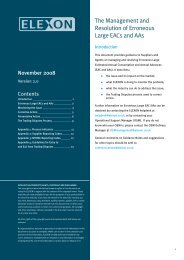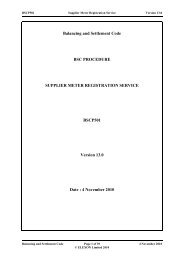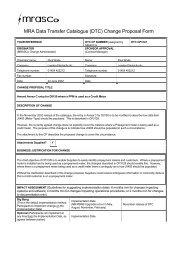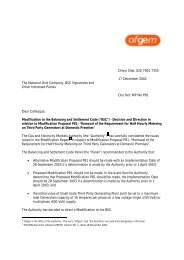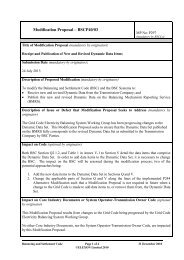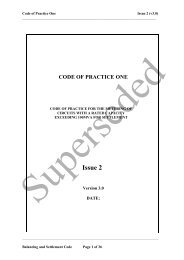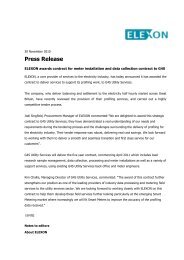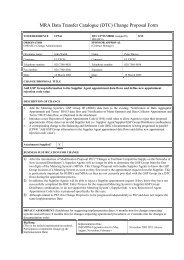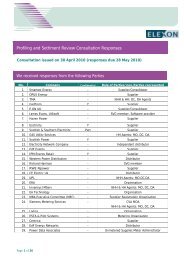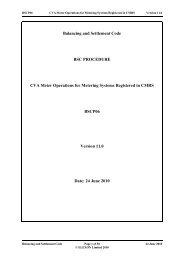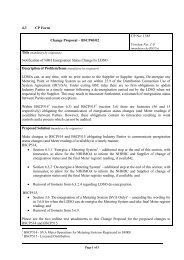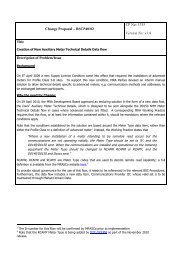PSRG22/01 - Elexon
PSRG22/01 - Elexon
PSRG22/01 - Elexon
Create successful ePaper yourself
Turn your PDF publications into a flip-book with our unique Google optimized e-Paper software.
Dynamic Switching Roadmap<br />
Dynamic Switching Roadmap 22 August 2<strong>01</strong>2<br />
Page 1 of 30 © ELEXON 2<strong>01</strong>2<br />
<strong>PSRG22</strong>/<strong>01</strong><br />
Meeting Name Profiling and Settlement Review Group (PSRG) : Dynamic Switching Workshop<br />
Meeting Date 22 August 2<strong>01</strong>2<br />
Purpose of paper For Information / Discussion<br />
Summary<br />
1. Introduction<br />
In April 2<strong>01</strong>2 we issued a consultation seeking views on what changes to BSC<br />
arrangements are likely to be needed to accommodate dynamic switching once smart<br />
meters with load switching capabilities have been rolled out and the current Radio<br />
Teleswitch Service (RTS) infrastructure is no longer available. The consultation also sought<br />
to establish what load/meters are currently being switched dynamically, by whom and for<br />
what purposes.<br />
Following the consultation, this paper presents a revised version of the ‘roadmap’ for the<br />
changes that are likely to be required to the BSC arrangements to take into account<br />
evolving dynamic switching requirements.<br />
1.1 The introduction of smart metering and the Data and Communications Company (DCC) will result in changes<br />
to how remote load control and dynamic switching instructions are issued.<br />
1.2 Currently the Radio Teleswitch Service (RTS) is the only widely-used mechanism for the dynamic switching<br />
of Non Half Hourly tariff registers. Almost two million customers have their electrical storage and immersion<br />
heating controlled remotely via the RTS. Messages are sent via the BBC’s 198 kHz long wave network to a<br />
teleswitch device in the customers’ meters to turn the customers’ heating on and off.<br />
1.3 Over the next few years this mechanism will fall into disuse, as the BBC’s 198 kHz long wave service is<br />
discontinued, and the new smart metering infrastructure will become the primary mechanism for dynamic<br />
switching.<br />
1.4 Under the current arrangements the Energy Networks Association (ENA) provides a single, daily report of<br />
teleswitch times to the Supplier Volume Allocation Agent (SVAA). The SVAA uses this file as part of the<br />
calculation of profile coefficients to ensure that energy (meter advances, energy that is recorded over longer<br />
periods by meter registers) is allocated to the correct half hour periods. Under the new smart arrangements<br />
the DCC (via the Data Services Provider) will process meter register switch requests and remote load control<br />
requests from Suppliers (and potentially) network operators and send commands to be applied by the<br />
relevant smart Electricity Metering System (EMS). This means that the mechanism for notifying switching<br />
times to the SVAA will need to be reviewed.<br />
2. Current Arrangements : The Radio Teleswitch Service (RTS)<br />
2.1 Under the current arrangements there are two ways in which the switching of load or time of use registers<br />
can be effected:
� locally by clock switching i.e. via a clock in (or attached to) the meter; or<br />
� remotely by Radio Teleswitching.<br />
Dynamic Switching Roadmap 22 August 2<strong>01</strong>2<br />
Page 2 of 30 © ELEXON 2<strong>01</strong>2<br />
<strong>PSRG22</strong>/<strong>01</strong><br />
2.2 In the case of clock switched meters, both the time-of-use registers and the switching times are pre-defined<br />
and registered as part of Market Domain Data (MDD). In the case of teleswitched meters, the registers are<br />
pre-defined and registered in MDD, but the switching times are notified to the SVAA on a daily basis by an<br />
agent of the ENA.<br />
2.3 Both clock switched and teleswitched meters can support a static regime (i.e. where the registers are<br />
switched at the same time every day of the year) or semi-static (i.e. where the registers are switched at the<br />
same time every day within a defined season). Teleswitched meters can also be switched dynamically. For<br />
example, some night storage heaters are controlled dynamically to take into account prevailing or forecast<br />
weather. Suppliers are responsible for determining register switching times and communicating them to the<br />
RTS Access Provider for onward transmission to Metering Systems via the administrator of the switching<br />
infrastructure (the role fulfilled by the ENA).<br />
2.4 Teleswitch commands can be programmed (i.e. issued in advance) or immediate – i.e. to shed/boost load<br />
quickly (e.g. in the event of loss of generation or periods of high demand). The latter is currently used<br />
sparingly, and creates issues for profiling accuracy in terms of determining whether a Settlement Period in<br />
which load shedding occurred should be treated as “on” or “off”.<br />
2.5 The current RTS arrangements are described in more detail in Appendix A. A glossary of terms is provided in<br />
Appendix B.<br />
3. The Future of the Radio Teleswitch Service<br />
3.1 The BBC has announced that it plans to discontinue long wave broadcasting from September 2<strong>01</strong>3. The<br />
Energy Retail Association (ERA) and Licensed Distribution System Operators (LDSO) have asked the ENA to<br />
investigate options, possibilities and costs of extending the service to 2<strong>01</strong>6 or 2<strong>01</strong>7.<br />
3.2 The BBC’s ‘Delivering Quality First’ report notes that there will be “no re-investment in Long Wave once the<br />
current infrastructure—which relies on technology that is no longer being manufactured—has reached the<br />
end of its life. In the long term, this will result in the end of Radio 4 on LW, although we do not expect the<br />
transmitters to fail in the current Charter period. If they do fail suddenly, we are committed to safeguarding<br />
the programming on Radio 4 LW and will use our analogue services to provide continued coverage”.<br />
3.3 In a letter to John Mottram, Head of Radio and International Broadcasting at the Department for Culture,<br />
Media and Sport (18 July 2<strong>01</strong>2), Alex Pryde, Director, BBC Distribution, reiterates the BBC’s position as set<br />
out in ‘Delivering Quality First’. He notes that the “BBC’s service is expected to close when the current<br />
infrastructure has reached the end of its life”. This is dependent on “the reliability of the small number of<br />
remaining valves that are fundamental to the transmitter at Droitwich”. He notes that a valve may last a<br />
1,000 hours or 10,000 hours and that one of the valves at Droitwich has been in service for more than a
100,000 hours.<br />
Dynamic Switching Roadmap 22 August 2<strong>01</strong>2<br />
Page 3 of 30 © ELEXON 2<strong>01</strong>2<br />
<strong>PSRG22</strong>/<strong>01</strong><br />
3.4 The BBC “has sufficient confidence from Arqiva” that the transmitters will last until end of the current BBC<br />
Charter period (end of 2<strong>01</strong>6) – “with careful maintenance, and flexibility both in terms of output power and<br />
lengths of outage and reductions in power for planned work, the BBC expects that this will be achievable but<br />
cannot be guaranteed”.<br />
3.5 The letter also notes that it may “be possible to continue to operate the service beyond 2<strong>01</strong>7, subject to the<br />
BBC’s Charter being renewed on terms which allowed us to do so” and “the BBC is willing to offer an<br />
extension of the data service to the Energy Networks Association for the remainder of the time that Radio 4<br />
Longwave is maintainable”.<br />
3.6 The BBC is re-procuring its transmission services for analogue radio and won’t be able to negotiate terms<br />
with the ENA until Spring 2<strong>01</strong>3 when the procurement has been completed.<br />
4. Load Control / Register Switching via the DCC<br />
4.1 The current process design assumption is that the DCC will not hold any information that allows Metering<br />
Systems to be grouped (e.g. by Standard Settlement Configuration) and meters to be addressed as a group.<br />
Suppliers and network operators will need to identify all the Metering Systems that they wish to address in<br />
requests to the DCC. As such it is envisaged that Suppliers and network operators will need to provide<br />
feedback on switch times to the SVAA, rather than the DCC. When registration is incorporated within the<br />
scope of the DCC in 2<strong>01</strong>6/17, this may need to be reviewed.<br />
4.2 Version 1.0 of the Smart Metering Implementation Programme (SMIP) Smart Metering Equipment Technical<br />
Specifications (SMETS) excludes functionality relating to the opening and closing of auxiliary load switches<br />
and relays. It is anticipated that details will be provided in SMETS version 2.0.<br />
4.3 It is not currently anticipated that there will be a SMIP requirement on communications service providers to<br />
support broadcast or multicast messages. This is because such a requirement would rule out certain<br />
communications technologies from the procurement process. As such, it is likely that load control<br />
instructions will be issued as “multiple unicast” messages – i.e. addressing individual Electricity Smart<br />
Metering Systems (ESMS) in quick succession. This is not to rule out broadcast or multicast messages<br />
entirely, but national coverage may not be complete, depending on the technologies selected.<br />
5. Statistics for existing Teleswitched Metering Systems<br />
5.1 Under the current arrangements just over two million customers have their electrical storage and immersion<br />
heating controlled remotely via the RTS. Of these just over 120,000 (6%) are Profile Class 4 customers and<br />
the remainder are Profile Class 2 customers. A breakdown by regime type is shown below. Please note that<br />
the estimated number of dynamically switched customers has reduced from the 1.5 million quoted in the<br />
version of this document that was consulted on. This is as a result of identifying active dynamic regimes via<br />
the consultation (as shown in Appendix C). A number of SSCs identified as still being dynamically switched
have few or no associated Metering Systems.<br />
Dynamic Switching Roadmap 22 August 2<strong>01</strong>2<br />
Page 4 of 30 © ELEXON 2<strong>01</strong>2<br />
<strong>PSRG22</strong>/<strong>01</strong><br />
Regime Profile Class 2 Profile Class 4<br />
Total<br />
MSID Count MSID Count MSID Count<br />
Dynamic 658,964 16,187 675,151<br />
(Semi-) Static 1,260,712 104,753 1,365,465<br />
Total MSIDs 1,919,676 120,940 2,040,616<br />
5.2 An energy breakdown by regime type is shown below. Values are annualised energy on the switched register<br />
only.<br />
Regime Profile Class 2 Profile Class 4<br />
Total<br />
MSID Count MSID Count MSID Count<br />
Dynamic 1,796,062 87,191 1,883,253<br />
(Semi-) Static 3,939,145 742,386 4,681,531<br />
Total (MWh) 5,735,207 829,577 6,564,784<br />
5.3 A breakdown of dynamically switched Metering Systems by Teleswitch User is shown below.<br />
Teleswitch<br />
User<br />
Profile Class 2<br />
MSID Count<br />
Profile Class 4<br />
Annual Switched<br />
Energy (MWh)<br />
Total<br />
Annual Switched<br />
Energy (MWh)<br />
East Midlands 407,596 13,298 420,894<br />
London 87,610 0 87,610<br />
Scottish Hydro 82,823 1,370 84,193<br />
Scottish Power 80,933 1,518 82,451<br />
South Eastern 0 1 1<br />
Southern 2 0 2<br />
Total MSIDs 658,964 16,187 675,151<br />
5.4 Annual energy volumes (for the switched register) are shown below.<br />
Regime Profile Class 2<br />
Annual Switched<br />
Energy (MWh)<br />
Profile Class 4<br />
Annual Switched<br />
Energy (MWh)<br />
Total<br />
Annual Switched<br />
Energy (MWh)<br />
East Midlands 671,252 58,099 729,351<br />
London 252,363 0 252,363<br />
Scottish Hydro 559,930 18,346 578,276<br />
Scottish Power 312,509 10,740 323,249<br />
South Eastern 0 7 7<br />
Southern 7 0 7<br />
Total MSIDs 1,796,062 87,191 1,883,253
Dynamic Switching Roadmap 22 August 2<strong>01</strong>2<br />
Page 5 of 30 © ELEXON 2<strong>01</strong>2<br />
<strong>PSRG22</strong>/<strong>01</strong><br />
5.5 Please note these are the counts and volumes associated with Metering Systems assigned to teleswitched<br />
Standard Settlement Configurations. The figures exclude Metering Systems assigned to teleswitch regimes,<br />
which consultation respondents indicated are not truly dynamic or would not be required in future. Metering<br />
Systems may be incorrectly assigned to teleswitch SSCs, so these figures are intended to give a high-level<br />
view, rather than to form the basis of detailed planning.<br />
6. Roadmap for Dynamic Switching<br />
6.1 We have identified three phases, which are described in more detail below:<br />
� Phase One – continuity of service for existing RTS customers;<br />
� Phase Two – new mechanism for dynamic switching; and<br />
� Phase Three – future developments.<br />
6.2 The purpose of describing these phases is to facilitate debate and planning. Given the duration of the smart<br />
metering roll-out, there are likely to be overlaps between the phases and the eventual implementation<br />
phases may be different.<br />
6.3 Although the developments described in Phase Three may be some years away, it is important that they are<br />
considered during the development of solutions in Phases One and Two, to ensure that these solutions are<br />
as future-proof as they can be.<br />
6.4 Whilst the PSRG is focused on the implications that the likely new mechanisms of dynamic switching will<br />
have for settlement, we recognise that the Settlement impacts cannot be fully considered in isolation of the<br />
wider industry context.<br />
7. Phase One – continuity of service for existing RTS customers<br />
7.1 Whilst the proposed removal of the current RTS has implications for profiling, the primary impact is on those<br />
customers who rely on the service for their storage heating. Therefore, the priority for Suppliers is to<br />
develop contingency proposals, in the event that the service is discontinued before a viable alternative has<br />
been implemented for dynamic switching.<br />
7.2 Any Metering Systems on static or semi-static teleswitch regimes can be migrated to a new ‘clock-switch’<br />
Standard Settlement Configuration (SSC) on installation of a smart meter, with switching scheduled via the<br />
ESMS or by the Supplier, depending on the functionality defined in SMETS version 2.0. No changes to the<br />
current BSC arrangements would be required in order to migrate Metering Systems on static and semi-static<br />
regimes. This would include any Metering Systems currently allocated to dynamically switched SSCs, which<br />
the Supplier and their customer are happy to move to a static or semi-static regime.<br />
7.3 Version 2 of the SMETS (incorporating the HAN and security requirements) is due to be notified to the EU in<br />
Quarter 4 2<strong>01</strong>2, with SMETS 2 compliant smart meters being manufactured from Quarter 1 2<strong>01</strong>3. With the
Dynamic Switching Roadmap 22 August 2<strong>01</strong>2<br />
Page 6 of 30 © ELEXON 2<strong>01</strong>2<br />
<strong>PSRG22</strong>/<strong>01</strong><br />
DCC expected to be in place and mass roll-out expected to begin in Quarter 3 2<strong>01</strong>4, this would allow (as a<br />
working assumption) a period of 2-3 years to install smart meters for RTS customers before the end of the<br />
current RTS service in (say) 2<strong>01</strong>6/17.<br />
7.4 Respondents to the consultation commented that the greatest risk was to dynamically switched customers if<br />
the RTS service failed. Their meters would resort to whatever default factory setting applied and the tariff<br />
conditions would not be met. On this basis it would be preferable to install smart meters for dynamically<br />
switched customers ahead of those on static or semi-statics regimes. On the other hand, the installation of<br />
smart meters for customers with no dynamic switching is not dependent on a new mechanism for notifying<br />
switching times to Settlement, so could start earlier (i.e. in the Foundation phase). Other respondents<br />
weren’t convinced for the need for separate phasing of dynamic and static customers or felt that more<br />
certainty on volumetrics was needed before a conclusion could be reached.<br />
8. Phase Two – new mechanism for dynamic switching<br />
New SVAA notification mechanism<br />
8.1 In order to reflect switched load in profiling, there needs to be a mechanism for Settlement to capture<br />
switch times. Currently, switch times for meters on dynamic meters are notified to the SVAA by the ENA on a<br />
daily basis as a single file. A new mechanism will be required for Suppliers to notify the SVAA of switching<br />
times and for the SVAA to process switch times from multiple sources. This will require a BSC Modification<br />
Proposal.<br />
8.2 This is assuming that Suppliers continue to settle dynamically switched Metering Systems under the Non Half<br />
Hourly arrangements. Trading dynamically switched Metering Systems under the Half Hourly arrangement<br />
would negate the need for such a mechanism, if applied globally.<br />
8.3 It is also assumes that there remains a need for dynamic switching. A minority of respondents to the<br />
consultation challenged the assumption that a new notification mechanism would be required, for example,<br />
if existing customers on dynamic regimes were moved to static or semi-static regimes.<br />
Supplier-specific Standard Settlement Configurations<br />
8.4 When a smart meter is installed, it is likely that the Metering System will need be changed to a new SSC. For<br />
static and semi-static regimes, this could be an existing or new clock-switched SSC. The DCC access control<br />
processes will not allow Suppliers to issue load control instructions to other Suppliers’ smart meters, so for<br />
dynamic regimes, the likelihood is that Supplier-specific SSCs will be needed. Smart meters will allow meters<br />
to be easily re-configured on change of Supplier, making Supplier-specific SSCs a practical proposal.<br />
8.5 We will need to consider whether Supplier, supplier agent and SMRAs need to validate Supplier/SSC<br />
combinations and how to ensure that smart meters for dynamically switched Metering Systems are always<br />
reconfigured on change of Supplier. Any changes to SMRS validation will need to be reviewed in the context<br />
of registration services moving to the DCC in 2<strong>01</strong>6/17.
Dynamic Switching Roadmap 22 August 2<strong>01</strong>2<br />
Page 7 of 30 © ELEXON 2<strong>01</strong>2<br />
<strong>PSRG22</strong>/<strong>01</strong><br />
8.6 We will also need to consider the availability of SSC codes (given that existing teleswitch SSCs will need to<br />
be retained for at least the duration of the smart roll-out) and also the impact of the increased dimensions of<br />
the Supplier Purchase Matrices processed by the DCC. There are currently about 4,700 combinations of<br />
Supplier and teleswitched SSC, but rather than leading to a proliferation of SSCs, the introduction of<br />
Supplier-specific SSCs would be an opportunity for the rationalisation of codes.<br />
Supplier-LDSO framework for dynamic switching<br />
8.7 Currently, LDSOs have to agree SSCs installed on their networks by Suppliers so that they can associate<br />
them with the correct Common Distribution Charging Methodology (CDCM) tariff in their billing systems, and<br />
record a valid Line Loss Factor Class/Meter Timeswitch Class (MTC)/ SSC combination in Market Domain<br />
Data (MDD). This process would be further complicated by the addition of Supplier-specific SSCs. The PSRG<br />
may wish to encourage LDSOs to review whether they will have an enduring requirement (under the new<br />
switching arrangements) to agree the SSCs used on their networks.<br />
8.8 Under the current arrangements, the Radio Teleswitch Agreement (to which Suppliers must become a party<br />
under section 28 of the Distribution Connection and Use of System Agreement (DCUSA)), sets out the<br />
responsibilities of the RTS Access Providers (i.e. the LDSOs) in providing Suppliers with access to the<br />
teleswitch infrastructure. Under any new arrangements there is likely to be a need for some form of<br />
framework agreement between Suppliers and LDSOs. This will need to protect LDSOs from any adverse<br />
impact on network loads from Supplier-specific load switching regimes or time of use tariffs. It will also need<br />
to protect Suppliers from any adverse impact that LDSO load control/load shedding may have on Suppliers’<br />
imbalance positions.<br />
8.9 The PSRG recognises that other groups, both inside and outside the industry, such as the ENA / ERA and<br />
Sustainability First, are taking forward work to consider the potential benefits and complexities around<br />
demand-side response. Ofgem also identified that changes to regulatory and commercial arrangements may<br />
be needed to facilitate efficient allocation of demand-side response in the future, as part of their consultation<br />
on promoting smarter energy markets.<br />
8.10 Respondents to the consultation were divided on this question. A couple of respondents questioned the need<br />
for a framework, with the remaining respondents suggesting that a framework should be in place before any<br />
significant load switching by Suppliers or at the start of the smart metering roll-out. One respondent<br />
suggested that a framework could be considered during 2<strong>01</strong>3, in conjunction with the work of delinking<br />
DUoS tariffs.<br />
9. Phase Three – future developments<br />
Time of Use Tariffs<br />
9.1 The need to capture switch times also applies to dynamically switched registers, where there is no load<br />
switching (or rather, load is switched by the customer in response to price messages from their Supplier). If<br />
Suppliers start to introduce innovative tariffs, such as critical peak pricing, there will be a need to a) notify
Dynamic Switching Roadmap 22 August 2<strong>01</strong>2<br />
Page 8 of 30 © ELEXON 2<strong>01</strong>2<br />
<strong>PSRG22</strong>/<strong>01</strong><br />
Settlement of the switch times and b) consider the impacts of such switching on network management. The<br />
message from Ofgem is that tariffs need to be simple and less confusing for the customer, so it is assumed<br />
that, where dynamic time of use tariffs are introduced, they will be in small numbers.<br />
9.2 Respondents to the consultation noted that some time of use tariffs are already being introduced/trialled,<br />
but truly dynamic time of use tariffs are unlikely to come into effect on a significant scale until there is good<br />
penetration of smart metering (2<strong>01</strong>8 to 2020 and beyond were suggested). On respondent assumed that<br />
customers on dynamic tariffs, such as critical peak pricing tariffs, would need to be settled half hourly.<br />
LDSO load control / demand side management<br />
9.3 Under the present RTS arrangements, Suppliers set the expectation of how a regime will work, but LDSOs<br />
can use the flexibility within the regime to manage local network constraints. We need to identify LDSOs<br />
future requirements for managing such constraints and their requirements to carry out their own load<br />
control/load shedding via the DCC. We will need to consider the impact that this may have on Supplier<br />
imbalance positions. There are clearly wider implications in terms of customers having their load managed<br />
by both Suppliers and LDSOs.<br />
9.4 Other developments may include:<br />
� LDSOs procuring demand side response in critical areas of their network (as an alternative to<br />
network reinforcement);<br />
� LDSOs using their own Time of Use registers (different to Supplier tariff registers) for<br />
network charging purposes (subject to LDSO registers being agreed as part of the SMETS).<br />
9.5 A consultation respondent noted the expectation that domestic scale demand side management would<br />
initially be championed by Suppliers and that their tariffs would incorporate any pricing signals from the<br />
LDSOs. They suggested that load control by LDSOs would not become material much before 2020.<br />
New Types of Controllable Load<br />
9.6 Currently remote load management can be used to control electrical storage heating and immersion (e.g.<br />
Economy 7 and variants). In the future, remotely controlled load limiting/load shedding could be possible for<br />
other types of circuit – for example, at electric vehicle charging points. Smart appliances may also provide<br />
new possibilities for remote load management. There may be more than one type of controllable load at an<br />
individual customer’s premises.<br />
9.7 Where electric vehicle charging points are public, the charging infrastructure may be shared between<br />
Suppliers (e.g. the customer swipes an ID card at the EV charging point to allocate the power to their own<br />
Supplier), which would clearly have implications for Settlement.<br />
9.8 It was noted by a consultation respondent that the widespread installation of low carbon technology (heat<br />
pumps, photo voltaic, EV charging) at the domestic level, to the extent that would be potentially disruptive
of distribution networks, was not expected until 2020 or after.<br />
Dynamic Switching Roadmap 22 August 2<strong>01</strong>2<br />
Page 9 of 30 © ELEXON 2<strong>01</strong>2<br />
<strong>PSRG22</strong>/<strong>01</strong>
10. Possible Timescales<br />
Dynamic Switching Roadmap 22 August 2<strong>01</strong>2<br />
Page 10 of 30 © ELEXON 2<strong>01</strong>2<br />
<strong>PSRG22</strong>/<strong>01</strong><br />
2<strong>01</strong>2 2<strong>01</strong>3 2<strong>01</strong>4 2<strong>01</strong>5 2<strong>01</strong>6 2<strong>01</strong>7 2<strong>01</strong>8 2<strong>01</strong>9 2020 2021<br />
SMETS 2<br />
notified to<br />
EU (Q4)<br />
PHASE 1<br />
PHASE 2<br />
PHASE 3<br />
Termination<br />
of RTS<br />
service?<br />
SMETS 2<br />
meters<br />
available<br />
(Q3)<br />
DCC contract<br />
signed<br />
(Q2)<br />
Develop new<br />
SVAA<br />
mechanism +<br />
Supplier SSCs<br />
(lead time 1-<br />
2 years)<br />
Develop new<br />
Supplier-<br />
LDSO<br />
framework<br />
(lead time 18<br />
months)<br />
Foundation?<br />
DCC Go-Live<br />
/ start of<br />
smart<br />
metering<br />
mass rollout<br />
(Q3/Q4)<br />
Implement<br />
new SVAA<br />
mechanism<br />
+ Supplier<br />
SSCs<br />
new Supplier<br />
– LDSO<br />
framework<br />
Possible extension to RTS service? (subject to ongoing negotiation)<br />
End of<br />
current<br />
BBC<br />
charter<br />
Registration<br />
incorporated<br />
in DCC<br />
Smart Meters installed for RTS customers<br />
Target rollout<br />
completion<br />
date (Q4)<br />
Dynamic Time of Use tariffs<br />
introduced<br />
LDSO load control / demand side<br />
management<br />
New controllable loads e.g. EV<br />
charging
Dynamic Switching Roadmap 22 August 2<strong>01</strong>2<br />
Page 11 of 30 © ELEXON 2<strong>01</strong>2<br />
<strong>PSRG22</strong>/<strong>01</strong><br />
Please note that the timetable is still uncertain in terms of the plans of suppliers to roll out smart metering and will<br />
be subject to any changes in the centralised DECC SMIP plan. It is noted that the roll-out of smart meters may<br />
continue beyond the end of 2<strong>01</strong>9.<br />
11. RAID Log<br />
11.1 The following Risks Assumptions Issues and Dependencies have been identified.<br />
Risks<br />
No. Risk Notes<br />
R<strong>01</strong> RTS equipment failure 1 prior to the transition of<br />
teleswitched customers to a new arrangement, would<br />
be to the detriment of customers. It is understood that<br />
meters would revert to previous switching commands<br />
or to a standard routine / fallback mode, although this<br />
is likely to be specific to meter types, and needs to be<br />
confirmed. Any power outage could then prevent<br />
switching according to previous clock settings. This<br />
might not leave customers totally without heating, but<br />
would have implications in terms of heating times.<br />
R02 Failure to extend the existing RTS contracts sufficiently<br />
will leave short timescales for migrating RTS customers<br />
to smart meters.<br />
R03 Delays to specification of SMETS 2 meters could result<br />
in delays in transitioning dynamically switched<br />
consumers, particularly if meter variants are required<br />
to support dynamic load control.<br />
R04 There is likely to be a discrepancy between the<br />
number of Metering Systems assigned to a<br />
Teleswitched SSC and the number of consumers who<br />
actually have switched load. Suppliers may not be<br />
aware that consumers no longer have electrical<br />
storage heating. This presents a risk to transition<br />
planning for Suppliers (including procuring correct<br />
numbers of each meter type).<br />
R05 A majority of RTS regimes were set up before<br />
competition was introduced in the retail market in<br />
1998. Some of the rational for these regimes has been<br />
Mitigations include prioritising dynamically<br />
switched customers in the smart metering<br />
rollout, ensuring that any extended RTS service<br />
is sufficiently robust and the availability of the<br />
Westerglen transmitter.<br />
A consultation respondent noted that the risk<br />
may be limited to a small number of customers<br />
with dynamic controlled heating circuits (e.g.<br />
Budget Warmth).<br />
Mitigation of replacing RTS meters with<br />
traditional (non-smart) meters would lead to<br />
unacceptable stranded asset costs. So<br />
imperative that contract extended for long<br />
enough to install smart meters.<br />
Delays will place greater reliance on the<br />
continuation of the RTS service. Consultation<br />
responses were divided on whether this is a<br />
significant risk.<br />
Risk needs to be managed by Suppliers. The<br />
cost of carrying out surveys in advance may be<br />
prohibitive, so the decision about what type of<br />
meter to install may not be made until the site<br />
visit.<br />
Different switching times within the tariff rules<br />
should not be an issue for the customer. The<br />
risk to the LDSO arises if a large load is switched<br />
1 News reports suggest that specially crafted glass valves used by the Droitwich transmitter in Worcestershire are “so rare that<br />
engineers say there are fewer than 10 in the world, and the BBC has been forced to buy up the entire global supply. Each lasts<br />
anywhere between one and 10 years, and when one of the last two blows the service will go quiet”. (Dan Sabbagh,<br />
guardian.co.uk, Sunday 9 October 2<strong>01</strong>1)
No. Risk Notes<br />
lost over time, so there is no clear picture of what RTS<br />
is used for. This creates uncertainty about the<br />
implications for the consumer, if they were to be<br />
allocated to a static/semi-static regime in future, and<br />
also the implications on network management, were<br />
this to happen. This presents a risk to transition<br />
planning for Suppliers and LDSOs.<br />
R06 On installation of a smart meter, the Metering System<br />
is likely to be assigned a new SSC (because it will no<br />
longer form part of the teleswitch group). This is likely<br />
to have implications for consumers (if not completely<br />
like-for-like), which Suppliers will need to manage. It<br />
could also have implications for Suppliers in terms of<br />
demand forecasting and for LDSOs in terms of network<br />
management.<br />
R07 There may also be demand forecasting / network<br />
management issues as a result of smart meters<br />
keeping better time than the existing devices used for<br />
clock-switching.<br />
R08 Load shedding, remote load control by LDSOs will<br />
impact Supplier imbalance positions and may cause<br />
customer issues.<br />
R09 Supplier-specific load switching regimes or time of use<br />
tariffs may have an adverse effect on network<br />
management for LDSOs.<br />
Dynamic Switching Roadmap 22 August 2<strong>01</strong>2<br />
Page 12 of 30 © ELEXON 2<strong>01</strong>2<br />
<strong>PSRG22</strong>/<strong>01</strong><br />
at the same time for simplicity on the Supplier<br />
side. Random offsets in Meters (or DCC load<br />
scheduling) should limit impact. In most GSP<br />
Groups RTS no longer forms part of the LDSO<br />
strategy for networks management (although<br />
there may be a need for switched restricted load<br />
in certain GSP Groups to manage constraints –<br />
e.g. the Scottish islands).<br />
Some of those respondents to the consultation<br />
who considered that this is a risk, suggested<br />
that the mitigation needed to be partnership<br />
solutions between LDSOs and Suppliers.<br />
Leaving aside any longer term collaboration<br />
between Suppliers and LDSO for network<br />
management purposes, new switching times (as<br />
a result of moving RTS customers on to<br />
static/semi-static regimes) may impact the load<br />
on the network.<br />
If randomisation of load switching is written into<br />
SMETS 2, this will mitigate this risk. This is<br />
clearly a transitional risk, because better timekeeping<br />
is a benefit in terms of Settlement<br />
accuracy (and customer billing).<br />
In the short term, load shedding is likely to be<br />
for network emergencies or limited (and well<br />
advised to the customers subject to it). A<br />
consultation respondent noted that LDSO<br />
switching is likely to be highly localised and<br />
unnoticeable to a Supplier at a national level.<br />
May be a longer term risk, if use of load control<br />
or demand side management increases.<br />
Suppliers expect that if a service is developed in<br />
future, the relationship between the LDSO and<br />
the consumer will need to be managed by the<br />
Supplier. In the longer term, the interaction of<br />
supplier wholesale imbalance, transmission<br />
system balancing actions and network operator<br />
actions will need to be considered to ensure an<br />
efficient overall outcome.<br />
A number of mitigations were proposed by<br />
consultation respondents, including bipartite<br />
contractual arrangements between Suppliers<br />
and LDSOs, a framework for inter-party working
No. Risk Notes<br />
R10 The DCC is not ready for the start of the smart<br />
metering rollout. With the track record of IT systems<br />
rarely being delivered on time, there is a major risk of<br />
control and communications systems being<br />
unavailable.<br />
R11 Suppliers may not prioritise RTS customers during the<br />
smart metering roll-out in order to mitigate against the<br />
risk of the RTS switch off.<br />
R12 The existing RTS system facilitates emergency load<br />
switching which is occasionally used by LDSOs to assist<br />
with the management of temporary network<br />
constraints. As with other functionality derived from<br />
the RTS, this relies upon the use of broadcast<br />
messaging to issue instructions to individual meters. It<br />
is likely that any similar functionality derived from a<br />
smart metering system will rely on multiple unicast<br />
messages sent from the DCC to individual meter<br />
points. This proposed system could increase the time<br />
taken for emergency load switching signals to be<br />
received at each meter point which in turn will<br />
potentially delay any benefit derived by issuing such an<br />
instruction.<br />
Assumptions<br />
No. Assumption Notes<br />
A<strong>01</strong> Under the new smart arrangements, Suppliers will<br />
communicate directly with the smart metering system<br />
via the administrator of the switching infrastructure<br />
(i.e. the DCC), rather than with an RTS Access<br />
Provider. This will apply in the case of static and semistatic<br />
switching, as well as dynamic switching (if<br />
required).<br />
A02 Under the new DCC processes, instructions issued by<br />
Suppliers may have to relate to individual Metering<br />
Systems, rather than groups of Metering Systems (due<br />
Dynamic Switching Roadmap 22 August 2<strong>01</strong>2<br />
Page 13 of 30 © ELEXON 2<strong>01</strong>2<br />
<strong>PSRG22</strong>/<strong>01</strong><br />
(along the lines of DCUSA Schedule 8) and an<br />
LDSO right of veto. One respondent noted that<br />
the LDSO may look to de-link their tariffs from<br />
those of the Supplier, manage the network at<br />
voltage level and modify the impact on the<br />
network by moving the time bands to reflect<br />
system peaks.<br />
New risk. Proposed by consultation respondent.<br />
New risk. Proposed by consultation respondent.<br />
New risk. Proposed by consultation respondent.<br />
Seen as a risk by one consultation respondent.<br />
See risk R12.
No. Assumption Notes<br />
to the requirements of the DCC service).<br />
A03 SMETS version 2.0 will support static/semi-static<br />
switching, and immediate switch load commands.<br />
A04 If any smart meters are installed during the<br />
Foundation Phase, they will be switched statically or<br />
semi-statically.<br />
Issues<br />
No. Issue Notes<br />
I<strong>01</strong> The SVAA needs to be notified of dynamic switch times<br />
in order to allocate profiled energy to the correct<br />
Settlement Periods. The change from centralised<br />
switching by the ENA’s agent to distributed switching<br />
by Suppliers (and potentially LDSOs), will require a<br />
change to the mechanism for notifying switch times to<br />
the SVAA (unless dynamically-switched Metering<br />
Systems are settled Half Hourly or no business<br />
requirement exists for dynamic switching).<br />
I02 Having a “sponsoring Supplier” in the form of an RTS<br />
Access Provider will not work under the new DCC<br />
arrangements. Suppliers will only be able to issue<br />
requests in respect of their own registered Metering<br />
Systems. This is likely to lead to Supplier-specific SSCs.<br />
I03 Consideration will need to be given to the validation of<br />
Supplier-specific SSCs in SMRS and Supplier agent<br />
systems and how to ensure that a new SSC is allocated<br />
when a dynamically switched consumer changes<br />
Supplier.<br />
I04 The need to maintain existing SSCs for legacy RTS<br />
Metering Systems in parallel with new Supplier-specific<br />
SSCs could result in a (short-term) proliferation of<br />
codes with MDD implications and impacts on the<br />
dimensions of Supplier Purchase Matrix (D0041) flows.<br />
Dynamic Switching Roadmap 22 August 2<strong>01</strong>2<br />
Page 14 of 30 © ELEXON 2<strong>01</strong>2<br />
<strong>PSRG22</strong>/<strong>01</strong><br />
Noted that smart meters currently being rolled<br />
out in Foundation have the capability to support<br />
switched loads. It is anticipated that SMETS 2<br />
will specify a configurable calendar (which can<br />
be changed at short notice), in addition to being<br />
able to switch load on/off remotely within very<br />
short timescales (e.g. minutes).<br />
Whilst there is nothing to prevent dynamic<br />
switching during the Foundation phase, switch<br />
times will not be reflected in Settlement.<br />
A suggestion that this could be managed by a<br />
bulk file provided to the SVAA by the DCC is not<br />
supported by the current DCC design, so would<br />
require a change under the SMIP.<br />
Generally agreed as an issue by consultation<br />
respondents. One view was that this could lead<br />
to a proliferation of SSCs, but LDSOs may<br />
choose, as now, not to support them within their<br />
DUoS charging mechanism.<br />
Generally agreed by consultation respondents to<br />
be an issue requiring further consideration.<br />
Generally agreed by consultation respondents to<br />
be an issue requiring further consideration.<br />
There are some redundant SSCs that could be<br />
reutilised.<br />
I05 In order to protect Suppliers from adverse impacts of Generally agreement among consultation
No. Issue Notes<br />
load control and load shedding by LDSOs and to<br />
protect LDSOs from adverse effects on their networks<br />
resulting from Supplier driven load control and Time of<br />
Use, there is likely to be a need for a common<br />
framework within which load control can be operated.<br />
I06 Currently LDSOs have to agree the SSCs installed on<br />
their networks by Suppliers (in order that they can<br />
associate them with the correct Common Distribution<br />
Charging Methodology (CDCM) tariff in their billing<br />
systems, and record a valid LLFC/SSC/MTC<br />
combination in MDD). These requirements need to be<br />
reviewed in the light of smart metering and smart<br />
grids. Is there an enduring requirement for LDSOs to<br />
agree the SSCs used on their networks and how will<br />
this be reconciled with Supplier-specific SSCs, which<br />
Suppliers will presumably wish to use on a national<br />
basis?<br />
Dependencies<br />
No. Dependency Notes<br />
D<strong>01</strong> Migration of RTS customers to the new smart<br />
arrangements will depend on the availability of<br />
sufficient smart meters with switching capability and<br />
interoperable auxiliary load control devices.<br />
12. Recommendations<br />
12.1 We invite you to:<br />
Dynamic Switching Roadmap 22 August 2<strong>01</strong>2<br />
Page 15 of 30 © ELEXON 2<strong>01</strong>2<br />
<strong>PSRG22</strong>/<strong>01</strong><br />
respondents that a framework would be<br />
required. Suggested governance included the<br />
DCUSA and the Smart Energy Code.<br />
Work on delinking for DUoS tariffs is being<br />
considered as part of the DCUSA Billing Group,<br />
which could go some way to addressing this<br />
issue. One Supplier noted that the current<br />
process for agreeing SSCs with DNOs can be<br />
arduous and time consuming and a review of<br />
the process and its barriers would be welcome.<br />
Suppliers will need to be able to identify these<br />
sites, preferably before a fitter visits to replace<br />
the legacy equipment.<br />
a) NOTE the revised Roadmap and RAID Log, as amended following the consultation.<br />
Appendices and Annex<br />
Appendix A – Radio Teleswitching Service (RTS)
Appendix B – Teleswitch Glossary<br />
Appendix C - List of Dynamic Regimes<br />
Appendix D - Dynamic Regimes with no corresponding Standard Settlement Configuration<br />
For more information, please contact:<br />
Jon Spence, Market Advisor<br />
jon.spence@elexon.co.uk<br />
020 7380 4313<br />
Dynamic Switching Roadmap 22 August 2<strong>01</strong>2<br />
Page 16 of 30 © ELEXON 2<strong>01</strong>2<br />
<strong>PSRG22</strong>/<strong>01</strong>
Appendix A: Radio Teleswitch Service<br />
Switching Instructions<br />
The Radio Teleswitch Service (RTS) is co-ordinated by the Energy Network Association (ENA).<br />
Dynamic Switching Roadmap 22 August 2<strong>01</strong>2<br />
Page 17 of 30 © ELEXON 2<strong>01</strong>2<br />
<strong>PSRG22</strong>/<strong>01</strong><br />
Suppliers and LDSOs liaise to create new switching regimes. These are approved under the BSC and recorded in<br />
Market Domain Data (MDD) as Standard Settlement Configurations (SSC), Teleswitch Time Pattern Regimes and<br />
Teleswitch Register Rules. Meter Operators then configure meters according to these pre-defined rules.<br />
Switching Instructions<br />
The radio teleswitches installed at consumer premises each respond to a pre-set Block Application Code (BAC),<br />
User ID (LDSO-specific) and Group Code. Radio teleswitches with the same BAC, User ID and Group Code respond<br />
simultaneously to a command (apart from a random offset to prevent demand spikes). The load is therefore<br />
aggregated. For example, a command to Group Code XX might switch 100MW. This aggregated load can be<br />
geographically dispersed. Charge to a storage heater can be a single block (e.g. 7 hours) or split into small blocks<br />
(down to a resolution of 7.5 minutes).<br />
Under the Radio Teleswitch Service Agreement, each Teleswitch Group has a sponsoring Supplier, who determines<br />
the switching times. The LDSOs act as providers of access to the teleswitch infrastructure. Switching instructions<br />
are notified to the Central Teleswitch Control Unit (CTCU), where switching instructions are validated and queued<br />
for transmission.<br />
LDSOs can also issue immediate messages (used to shed or boost load) in addition to programmed messages,<br />
within pre-determined operating windows.<br />
The CTCU is owned by the Energy Network Association (ENA) who co-ordinate the RTS service on behalf of LDSOs.<br />
The CTCU is operated and maintained by Cygnet Solutions under a contract with the ENA. The BBC then encodes<br />
switching instructions on its 198 kHz signal and these are transmitted simultaneously via three radio transmitters at<br />
Droitwich, Westerglen and Burghead (operated by Arqiva). This process is illustrated in Figure 1.<br />
Teleswitch Monitoring<br />
Teleswitch Monitoring is defined as a BSC service in Section E of the Code. The role of Teleswitch Agent is fulfilled<br />
by the ENA. The primary functions of the Teleswitch Agent, as defined in Section S 4.3 of the BSC, include<br />
monitoring and logging switching time messages and sending details to the SVAA. The ENA uses a network of<br />
monitors, provide by Cable and Wireless, to log the messages broadcast by the three radio transmitters.<br />
Translation of the data log into files for notification to the SVAA is then performed by PowerDev on behalf of the<br />
ENA. The data is sent to the SVAA daily on a Teleswitch Data Interface File (D0277). This process is illustrated in<br />
Figure 2.
Figure 1 RTS Transmission<br />
CENTRAL TELESWITCH CONTROL UNIT (CTCU)<br />
OPERATED BY CYGNET SOLUTIONS FOR ENA<br />
MESSAGE ASSEMBLER (BBC CRYSTAL PALACE)<br />
DATA ENCODED ON 198 kHz RADIO 4 LONGWAVE<br />
(BBC BROADCASTING HOUSE)<br />
Droitwich Burghead<br />
SWITCHING INSTRUCTIONS BROADCAST TO RADIO<br />
TELESWITCHES IN CONSUMER PREMISES<br />
Dynamic Switching Roadmap 22 August 2<strong>01</strong>2<br />
Page 18 of 30 © ELEXON 2<strong>01</strong>2<br />
<strong>PSRG22</strong>/<strong>01</strong><br />
Westerglen
Figure 2 RTS Monitoring<br />
Dynamic Switching Roadmap 22 August 2<strong>01</strong>2<br />
Page 19 of 30 © ELEXON 2<strong>01</strong>2<br />
<strong>PSRG22</strong>/<strong>01</strong><br />
Droitwich Burghead Westerglen<br />
NETWORK OF MONITORS (PROVIDED BY CABLE &<br />
WIRELESS) USED BY CCTU TO MONITOR AND LOG<br />
BROADCAST MESSAGES<br />
TRANSLATION OF LOG MESSAGES INTO DAILY TELESWITCH<br />
FILES (BY POWERDEV ON BEHALF OF ENA) FOR USE BY THE<br />
SUPPLIER VOLUME ALLOCATION AGENT (SVAA)<br />
Teleswitch Data Interface File<br />
(D0277)<br />
SVAA USES TELESWITCH TIMES TO ‘CHUNK’ PROFILES
Appendix B Teleswitch Glossary<br />
The table below explains the roles and technical terms referred to in this paper.<br />
Term Explanation<br />
Administrator of switching<br />
infrastructure<br />
Dynamic Switching Roadmap 22 August 2<strong>01</strong>2<br />
Page 20 of 30 © ELEXON 2<strong>01</strong>2<br />
<strong>PSRG22</strong>/<strong>01</strong><br />
This role is responsible for the IT systems and communications<br />
infrastructure needed to transmit signals to meters. It is<br />
currently performed by the Energy Network Association (ENA)<br />
and its contracted agents (including the BBC). The smart<br />
metering equivalent will be the DCC and DCC Service Providers.<br />
Broadcast Transmit the same data to all possible destinations (see also<br />
Multicast and Unicast).<br />
Central Teleswitch Control Unit The system used to collate and direct switching times to the<br />
(CTCU)<br />
British Broadcasting Corporation (BBC).<br />
Data and Communications<br />
The new entity that will be created and licensed to deliver<br />
Company (DCC)<br />
central data and communications activities for smart metering.<br />
Dynamic Switching Teleswitching that can vary by both time and duration on a<br />
daily basis.<br />
Foundation Phase The period between publication of the Government’s Response<br />
to the Smart Metering Prospectus consultation (March 2<strong>01</strong>1)<br />
and the beginning of the mass roll-out of smart meters<br />
(assumed to be start of Quarter 4 2<strong>01</strong>4). In particular, the<br />
period following the finalisation of the Smart Metering<br />
Equipment Technical Specification (during 2<strong>01</strong>2) and the mass<br />
roll-out, when parties responsible for delivering smart meters<br />
test the end-to-end system and its individual elements.<br />
Group Code ID An identifier used to define groups of teleswitch metering<br />
systems that will be switched simultaneously defined in MDD as<br />
the Teleswitch Group ID.<br />
Message Assembler (BBC Crystal The device that encodes the teleswitch instructions for<br />
Palace)<br />
broadcast on 198 kHz RADIO 4 Longwave.<br />
Multicast Transmit messages to a specified group of destination<br />
addresses (see also Broadcast and Unicast).<br />
Profile Class 2 (Domestic Economy Customers at a domestic premises, as defined in the terms of<br />
7 Customers)<br />
the Supply licence, that are on a Domestic Economy 7 or similar<br />
tariff that have a metering system that is capable of switching<br />
load, e.g. Storage and Immersion Heating.<br />
Profile Class 4 (Non-Domestic Customers at a non-domestic premises, as defined in the terms<br />
Economy 7 Customers)<br />
of the Supply licence, that are on a Non-Domestic Economy 7<br />
or similar tariff that have a metering system that is capable of<br />
switching load, e.g. Storage and Immersion Heating.<br />
RTS Access Provider The design of the RTS infrastructure limits the number of<br />
‘users’ to 16, making it impossible for individual Suppliers to<br />
communicate directly with the administrator of the switching<br />
infrastructure. To overcome this, the Radio Teleswitch<br />
Agreement assigns to LDSOs the role of RTS Access Provider,<br />
acting as ‘middle man’ between Suppliers and the administrator<br />
of the switching infrastructure.<br />
Radio Teleswitch Agreement (RTA) The commercial framework that allows Suppliers access to the<br />
teleswitching infrastructure.<br />
Radio Teleswitch Service (RTS) The Service co-ordinated by the Energy Networks Association
Dynamic Switching Roadmap 22 August 2<strong>01</strong>2<br />
Page 21 of 30 © ELEXON 2<strong>01</strong>2<br />
<strong>PSRG22</strong>/<strong>01</strong><br />
Term Explanation<br />
(ENA) on behalf of Market Participants.<br />
Semi-Static Teleswitching that varies occasionally e.g. at weekend or by<br />
GMT/BST.<br />
Static Switching Teleswitching that is the same every day.<br />
Teleswitch Agent The BSC Agent (currently the ENA) responsible for monitoring<br />
and logging switching time messages and sending details to the<br />
SVAA.<br />
Teleswitch Data Interface File The data file sent to the Supplier Volume Allocation Agent<br />
(D0277)<br />
detailing the Switching times for each Teleswitch Group.<br />
Teleswitch Monitors The devices that record the broadcast teleswitch signals and<br />
log them on the CTCU.<br />
Teleswitch Register Rules The rules that define which Teleswitch Registers are<br />
operational when the teleswitched meters implement switching<br />
instructions.<br />
Teleswitch Time Pattern Regimes The mapping of Teleswitched Registers to the Teleswitch Users<br />
Ids and Teleswitch Group Ids in MDD.<br />
Teleswitched meters Meters that are connected to a Teleswitch.<br />
Unicast Transmit messages to a single destination identified by a<br />
unique address (see also Broadcast and Multicast).<br />
User ID (LDSO-specific) The ID of the LDSO acting as the RTS access provider defined<br />
in Market Domain Data (MDD) as the Teleswitch User ID.
Appendix C: List of Dynamic Regimes<br />
TS User TS<br />
User<br />
Id<br />
TS User<br />
Group<br />
Dynamic Switching Roadmap 22 August 2<strong>01</strong>2<br />
Page 22 of 30 © ELEXON 2<strong>01</strong>2<br />
SSC SSC Description Status<br />
<strong>PSRG22</strong>/<strong>01</strong><br />
London 1 1 156 7-hour E7 Dynamic switching not undertaken<br />
by LDSO<br />
London 1 2 157 7-hour E7 Dynamic switching not undertaken<br />
by LDSO<br />
London 1 6 313 Domestic E9 A Dynamic switching not undertaken<br />
by LDSO<br />
London 1 6 324 Domestic E9 B Dynamic switching not undertaken<br />
by LDSO<br />
London 1 7 158 7-hour E7 Dynamic switching not undertaken<br />
by LDSO (but used by Supplier for<br />
demand response)<br />
London 1 9 245 7-hour night Dynamic switching not undertaken<br />
by LDSO<br />
South Eastern 2 7 160 7-hour E7 Dynamic switching not undertaken<br />
by LDSO<br />
South Eastern 2 17 161 7-hour E7 Dynamic switching not undertaken<br />
by LDSO<br />
South Eastern 2 27 162 7-hour E7 Dynamic switching not undertaken<br />
by LDSO<br />
South Eastern 2 32 339 Local Authority Heating Still dynamically switched by LDSO<br />
South Eastern 2 34 340 Local Authority Heating Still dynamically switched by LDSO<br />
South Eastern 2 36 341 Local Authority Heating Still dynamically switched by LDSO<br />
South Eastern 2 37 163 7-hour E7 Dynamic switching not undertaken<br />
by LDSO<br />
South Eastern 2 40 288 Budget Warmth Still dynamically switched by LDSO<br />
South Eastern 2 47 164 7-hour E7 Dynamic switching not undertaken<br />
by LDSO<br />
South Eastern 2 48 165 7-hour E7 Dynamic switching not undertaken<br />
by LDSO<br />
South Eastern 2 52 289 Budget Warmth Still dynamically switched by LDSO<br />
South Eastern 2 57 241 7-hour E7 (differential switching) Dynamic switching not undertaken<br />
by LDSO<br />
South Eastern 2 60 350 Warmwise heating Dynamic switching not undertaken<br />
by LDSO<br />
South Eastern 2 60 395 Warmwise Day/Night Dynamic switching not undertaken<br />
by LDSO<br />
South Eastern 2 67 166 7-hour E7 Dynamic switching not undertaken<br />
by LDSO<br />
South Eastern 2 70 290 Budget Warmth Dynamic switching not undertaken<br />
by LDSO<br />
South Eastern 2 100 291 Budget Warmth Still dynamically switched by LDSO<br />
South Eastern 2 120 292 Budget Warmth Still dynamically switched by LDSO<br />
Southern 3 1 299 Budget Warmth Still dynamic – weather dependent<br />
charge control<br />
Southern 3 2 303 Budget Warmth Still dynamic – weather dependent
TS User TS<br />
User<br />
Id<br />
TS User<br />
Group<br />
Dynamic Switching Roadmap 22 August 2<strong>01</strong>2<br />
Page 23 of 30 © ELEXON 2<strong>01</strong>2<br />
SSC SSC Description Status<br />
<strong>PSRG22</strong>/<strong>01</strong><br />
charge control<br />
Southern 3 6 167 7-hour E7 Dynamic switching not undertaken<br />
by LDSO<br />
Southern 3 7 168 7-hour E7 Dynamic switching not undertaken<br />
by LDSO<br />
Southern 3 8 169 7-hour E7 Dynamic switching not undertaken<br />
by LDSO<br />
Southern 3 9 170 7-hour E7 Dynamic switching not undertaken<br />
by LDSO<br />
Southern 3 10 171 7-hour E7 Dynamic switching not undertaken<br />
by LDSO<br />
Southern 3 11 172 7-hour E7 Dynamic switching not undertaken<br />
by LDSO<br />
Southern 3 12 173 7-hour E7 Dynamic switching not undertaken<br />
by LDSO<br />
Southern 3 17 174 7-hour E7 Dynamic switching not undertaken<br />
by LDSO<br />
Southern 3 20 175 7-hour E7 Dynamic switching not undertaken<br />
by LDSO<br />
Southern 3 29 300 Flexiheat Day/Evening/Weekend Semi dynamic<br />
Southern 3 29 351 Flexiheat heating Dynamic switching not undertaken<br />
by LDSO<br />
Southern 3 30 304 Budget Warmth Still dynamic – weather dependent<br />
charge control<br />
Southern 3 31 305 Domestic heating tariff Still dynamic – weather dependent<br />
charge control<br />
Southern 3 32 306 Domestic heating tariff Still dynamic – weather dependent<br />
charge control<br />
Southern 3 37 271 8-hour OP Dynamic switching not undertaken<br />
by LDSO<br />
Southern 3 38 272 8-hour OP Dynamic switching not undertaken<br />
by LDSO<br />
Southern 3 39 273 8-hour OP Dynamic switching not undertaken<br />
by LDSO<br />
Southern 3 40 307 Domestic heating tariff Still dynamic – weather dependent<br />
charge control<br />
Southern 3 41 308 Domestic heating tariff Still dynamic – weather dependent<br />
charge control<br />
Southern 3 50 3<strong>01</strong> Flexiheat (weather)<br />
Day/Evening/Weekend<br />
Semi dynamic<br />
Southern 3 50 352 Flexiheat (weather) heating Still dynamic – weather dependent<br />
charge control<br />
Southern 3 51 309 Superdeal (weather) Day/Night Dynamic switching not undertaken<br />
by LDSO<br />
Southern 3 51 425 Superdeal (weather) heating Still dynamic – weather dependent<br />
charge control<br />
Southern 3 52 302 Superdeal Day/Night Dynamic switching not undertaken<br />
by LDSO<br />
Southern 3 52 353 Superdeal heating Dynamic switching not undertaken<br />
by LDSO<br />
Southern 3 70 10 10.5-hour OP Still dynamic – weather dependent<br />
charge control
TS User TS<br />
User<br />
Id<br />
TS User<br />
Group<br />
Dynamic Switching Roadmap 22 August 2<strong>01</strong>2<br />
Page 24 of 30 © ELEXON 2<strong>01</strong>2<br />
SSC SSC Description Status<br />
<strong>PSRG22</strong>/<strong>01</strong><br />
Southern 3 90 274 8-hour OP Dynamic switching not undertaken<br />
by LDSO<br />
Eastern 5 10 310 E10 type 1 (general purpose) Dynamic switching not undertaken<br />
by LDSO<br />
Eastern 5 10 4<strong>01</strong> E10 type 1(heating circuit) Dynamic switching not undertaken<br />
by LDSO<br />
Eastern 5 64 381 split 7-hour E7 Dynamic switching not undertaken<br />
by LDSO<br />
Eastern 5 66 382 split 7-hour E7 Dynamic switching not undertaken<br />
by LDSO<br />
Eastern 5 88 248 7-hour E7 Dynamic switching not undertaken<br />
by LDSO<br />
Eastern 5 95 384 7-hour E7 Dynamic switching not undertaken<br />
by LDSO<br />
Eastern 5 97 426 7-hour E7 Dynamic switching not undertaken<br />
by LDSO<br />
Eastern 5 98 188 7-hour E7 Dynamic switching not undertaken<br />
by LDSO<br />
Eastern 5 99 126 7-hour E7 Dynamic switching not undertaken<br />
by LDSO<br />
East Midlands 6 40 358 split 10-hour Heatwise Dynamic – E.On switching daily<br />
East Midlands 6 41 359 split 10-hour Heatwise Dynamic – E.On switching daily<br />
East Midlands 6 42 360 split 10-hour Heatwise Dynamic – E.On switching daily<br />
East Midlands 6 43 361 split 10-hour Heatwise Dynamic – E.On switching daily<br />
East Midlands 6 44 362 split 10-hour Heatwise Dynamic – E.On switching daily<br />
East Midlands 6 45 363 split 10-hour Heatwise Dynamic – E.On switching daily<br />
East Midlands 6 46 364 split 10-hour Heatwise Dynamic – E.On switching daily<br />
East Midlands 6 47 365 split 10-hour Heatwise Dynamic – E.On switching daily<br />
East Midlands 6 48 366 split 10-hour Heatwise Dynamic – E.On switching daily<br />
East Midlands 6 49 367 split 10-hour Heatwise Dynamic – E.On switching daily<br />
East Midlands 6 50 368 split 10-hour Heatwise Dynamic – E.On switching daily<br />
East Midlands 6 51 369 split 10-hour Heatwise Dynamic – E.On switching daily<br />
East Midlands 6 52 370 split 10-hour Heatwise Dynamic – E.On switching daily<br />
East Midlands 6 53 371 split 10-hour Heatwise Dynamic – E.On switching daily<br />
East Midlands 6 70 189 7-hour E7 E.On smart metering?<br />
East Midlands 6 85 191 7-hour E7 Dynamic E7<br />
East Midlands 6 86 192 7-hour E7 Dynamic E7<br />
East Midlands 6 87 193 7-hour E7 Dynamic E7<br />
East Midlands 6 88 194 7-hour E7 Dynamic E7<br />
East Midlands 6 89 195 7-hour E7 Dynamic E7<br />
East Midlands 6 90 196 7-hour E7 Dynamic E7<br />
East Midlands 6 91 197 7-hour E7 Dynamic E7<br />
East Midlands 6 92 198 7-hour E7 Dynamic E7<br />
East Midlands 6 93 199 7-hour E7 Dynamic E7
TS User TS<br />
User<br />
Id<br />
TS User<br />
Group<br />
Dynamic Switching Roadmap 22 August 2<strong>01</strong>2<br />
Page 25 of 30 © ELEXON 2<strong>01</strong>2<br />
SSC SSC Description Status<br />
<strong>PSRG22</strong>/<strong>01</strong><br />
East Midlands 6 1<strong>01</strong> 385 split 7-hour E7 E.On smart metering?<br />
East Midlands 6 106 388 split 7-hour E7 Dynamic E7<br />
Scottish Power 13 20 770 18-hour dynamic Semi-static<br />
Scottish Power 13 30 787 E7 accompanying Birmingham<br />
Weathercall<br />
Dynamic – carried forward<br />
Scottish Power 13 30 788 Birmingham Weathercall Dynamic – carried forward<br />
Scottish Power 13 31 789 E7 accompanying Manchester<br />
Weathercall<br />
Dynamic – carried forward<br />
Scottish Power 13 31 790 Manchester Weathercall Dynamic – carried forward<br />
Scottish Power 13 32 791 E7 accompanying Anglesey<br />
Weathercall<br />
Dynamic – carried forward<br />
Scottish Power 13 32 792 Anglesey Weathercall Dynamic – carried forward<br />
Scottish Power 13 33 Code not broadcast – not needed<br />
Scottish Power 13 34 Code not broadcast – not needed<br />
Scottish Power 13 97 764 8.5 hour WM Dynamic – carried forward<br />
Scottish Power 13 97 765 Weathercall heating Dynamic – carried forward<br />
Scottish Power 13 98 766 8.5 hour WM Dynamic – carried forward<br />
Scottish Power 13 98 767 Weathercall heating Dynamic – carried forward<br />
Scottish Power 13 99 768 8.5 hour WM Dynamic – carried forward<br />
Scottish Power 13 99 769 Weathercall heating Dynamic – carried forward<br />
Scottish Power 13 100 752 8.5 hour WM Dynamic – carried forward<br />
Scottish Power 13 100 753 Weathercall heating Dynamic – carried forward<br />
Scottish Power 13 1<strong>01</strong> 754 8.5 hour WM Dynamic – carried forward<br />
Scottish Power 13 1<strong>01</strong> 755 Weathercall heating Dynamic – carried forward<br />
Scottish Power 13 102 756 8.5 hour WM Dynamic – carried forward<br />
Scottish Power 13 102 757 Weathercall heating Dynamic – carried forward<br />
Scottish Power 13 103 758 8.5 hour WM Dynamic – carried forward<br />
Scottish Power 13 103 759 Weathercall heating Dynamic – carried forward<br />
Scottish Power 13 104 760 8.5 hour WM Dynamic – carried forward<br />
Scottish Power 13 104 761 Weathercall heating Dynamic – carried forward<br />
Scottish Power 13 105 762 8.5 hour WM Dynamic – carried forward<br />
Scottish Power 13 105 763 Weathercall heating Dynamic – carried forward<br />
Scottish Power 13 109 793 8.5 hour WM Semi-static<br />
Scottish Power 13 109 794 8.5 hour WM Heating Semi-static<br />
Scottish Power 13 111 727 8.5 hour WM Semi-static<br />
Scottish Power 13 111 728 8.5 hour WM Heating Semi-static<br />
Scottish Power 13 112 729 8.5 hour WM Semi-static<br />
Scottish Power 13 112 730 8.5 hour WM Heating Semi-static<br />
Scottish Power 13 113 731 8.5 hour WM Semi-static<br />
Scottish Power 13 113 732 8.5 hour WM Heating Semi-static
TS User TS<br />
User<br />
Id<br />
TS User<br />
Group<br />
Dynamic Switching Roadmap 22 August 2<strong>01</strong>2<br />
Page 26 of 30 © ELEXON 2<strong>01</strong>2<br />
SSC SSC Description Status<br />
Scottish Power 13 114 733 8.5 hour WM Semi-static<br />
Scottish Power 13 114 734 8.5 hour WM Heating Semi-static<br />
Scottish Power 13 115 735 8.5 hour WM Semi-static<br />
Scottish Power 13 115 736 8.5 hour WM Heating Semi-static<br />
Scottish Power 13 116 737 8.5 hour WM Semi-static<br />
Scottish Power 13 116 738 8.5 hour WM Heating Semi-static<br />
Scottish Power 13 117 739 8.5 hour WM Semi-static<br />
Scottish Power 13 117 740 8.5 hour WM Heating Semi-static<br />
Scottish Power 13 118 741 8.5 hour WM Semi-static<br />
Scottish Power 13 118 742 8.5 hour WM Heating Semi-static<br />
Scottish Power 13 119 743 8.5 hour WM Semi-static<br />
Scottish Power 13 119 744 8.5 hour WM Heating Semi-static<br />
Scottish Power 13 120 745 8.5 hour WM Semi-static<br />
Scottish Power 13 120 746 8.5 hour WM Heating Semi-static<br />
Scottish Power 13 122 748 8.5 hour WM Semi-static<br />
Scottish Power 13 122 749 8.5 hour WM Heating Semi-static<br />
<strong>PSRG22</strong>/<strong>01</strong><br />
Scottish Hydro 14 15 802 Two rate with 8 hours night Still dynamically switched by LDSO<br />
Scottish Hydro 14 15 803 Dynamic Still dynamically switched by LDSO<br />
Scottish Hydro 14 16 804 Two rate with 8 hours night Still dynamically switched by LDSO<br />
Scottish Hydro 14 16 805 Dynamic Still dynamically switched by LDSO<br />
Scottish Hydro 14 17 806 Two rate with 8 hours night Still dynamically switched by LDSO<br />
Scottish Hydro 14 17 807 Dynamic Still dynamically switched by LDSO<br />
Scottish Hydro 14 18 850 Dynamic Still dynamically switched by LDSO<br />
Scottish Hydro 14 25 808 Two rate with 8 hours night Still dynamically switched by LDSO<br />
Scottish Hydro 14 25 809 Dynamic Still dynamically switched by LDSO<br />
Scottish Hydro 14 26 810 Two rate with 8 hours night Still dynamically switched by LDSO<br />
Scottish Hydro 14 26 811 Dynamic Still dynamically switched by LDSO<br />
Scottish Hydro 14 27 812 Two rate with 8 hours night Still dynamically switched by LDSO<br />
Scottish Hydro 14 27 813 Dynamic Still dynamically switched by LDSO<br />
Scottish Hydro 14 28 933 Two rate with 8 hours night Still dynamically switched by LDSO<br />
Scottish Hydro 14 28 934 Dynamic Not currently used dynamically<br />
Scottish Hydro 14 32 890 Dynamic Still dynamically switched by LDSO<br />
Scottish Hydro 14 35 814 Two rate with 8 hours night Still dynamically switched by LDSO<br />
Scottish Hydro 14 35 815 Dynamic Still dynamically switched by LDSO<br />
Scottish Hydro 14 36 816 Two rate with 8 hours night Still dynamically switched by LDSO<br />
Scottish Hydro 14 36 817 Dynamic Still dynamically switched by LDSO<br />
Scottish Hydro 14 37 818 Two rate with 8 hours night Still dynamically switched by LDSO<br />
Scottish Hydro 14 37 819 Dynamic Still dynamically switched by LDSO<br />
Scottish Hydro 14 38 851 Dynamic Still dynamically switched by LDSO
TS User TS<br />
User<br />
Id<br />
TS User<br />
Group<br />
Dynamic Switching Roadmap 22 August 2<strong>01</strong>2<br />
Page 27 of 30 © ELEXON 2<strong>01</strong>2<br />
SSC SSC Description Status<br />
<strong>PSRG22</strong>/<strong>01</strong><br />
Scottish Hydro 14 45 820 Two rate with 8 hours night Still dynamically switched by LDSO<br />
Scottish Hydro 14 45 821 Dynamic Still dynamically switched by LDSO<br />
Scottish Hydro 14 46 822 Two rate with 8 hours night Still dynamically switched by LDSO<br />
Scottish Hydro 14 46 823 Dynamic Still dynamically switched by LDSO<br />
Scottish Hydro 14 47 824 Two rate with 8 hours night Still dynamically switched by LDSO<br />
Scottish Hydro 14 47 825 Dynamic Still dynamically switched by LDSO<br />
Scottish Hydro 14 63 865 Two rate with 8 hours night Not currently used dynamically<br />
Scottish Hydro 14 63 866 Dynamic Not currently used dynamically<br />
Scottish Hydro 14 64 867 Two rate with 8 hours night Not currently used dynamically<br />
Scottish Hydro 14 64 868 Dynamic Not currently used dynamically<br />
Scottish Hydro 14 65 869 Two rate with 8 hours night Not currently used dynamically<br />
Scottish Hydro 14 65 870 Dynamic Not currently used dynamically<br />
Scottish Hydro 14 66 871 Two rate with 8 hours night Not currently used dynamically<br />
Scottish Hydro 14 66 872 Dynamic Not currently used dynamically<br />
Scottish Hydro 14 67 826 Two rate with 8 hours night Not currently used dynamically<br />
Scottish Hydro 14 67 827 Dynamic Not currently used dynamically<br />
Scottish Hydro 14 68 828 Two rate with 8 hours night Not currently used dynamically<br />
Scottish Hydro 14 68 829 Dynamic Not currently used dynamically<br />
Scottish Hydro 14 69 830 Two rate with 8 hours night Not currently used dynamically<br />
Scottish Hydro 14 69 831 Dynamic Not currently used dynamically<br />
Scottish Hydro 14 71 873 Two rate with 8 hours night Not currently used dynamically<br />
Scottish Hydro 14 71 874 Dynamic Not currently used dynamically<br />
Scottish Hydro 14 75 834 Two rate with 8 hours night Not currently used dynamically<br />
Scottish Hydro 14 75 835 Dynamic Not currently used dynamically<br />
Scottish Hydro 14 76 836 Two rate with 8 hours night Not currently used dynamically<br />
Scottish Hydro 14 76 837 Dynamic Not currently used dynamically<br />
Scottish Hydro 14 77 838 Two rate with 8 hours night Not currently used dynamically<br />
Scottish Hydro 14 77 839 Dynamic Not currently used dynamically<br />
Scottish Hydro 14 78 897 Dynamic Not currently used dynamically<br />
Scottish Hydro 14 79 898 Dynamic Not currently used dynamically<br />
Scottish Hydro 14 80 891 Dynamic Not currently used dynamically<br />
Scottish Hydro 14 81 875 Two rate with 8 hours night Not currently used dynamically<br />
Scottish Hydro 14 81 876 Dynamic Not currently used dynamically<br />
Scottish Hydro 14 94 840 Two rate with 8 hours night Not currently used dynamically<br />
Scottish Hydro 14 94 841 Dynamic Not currently used dynamically<br />
Scottish Hydro 14 95 842 Two rate with 8 hours night Not currently used dynamically<br />
Scottish Hydro 14 95 843 Dynamic Not currently used dynamically<br />
Scottish Hydro 14 96 844 Two rate with 8 hours night Not currently used dynamically<br />
Scottish Hydro 14 96 845 Dynamic Not currently used dynamically
TS User TS<br />
User<br />
Id<br />
TS User<br />
Group<br />
Dynamic Switching Roadmap 22 August 2<strong>01</strong>2<br />
Page 28 of 30 © ELEXON 2<strong>01</strong>2<br />
SSC SSC Description Status<br />
<strong>PSRG22</strong>/<strong>01</strong><br />
Scottish Hydro 14 97 892 Dynamic Not currently used dynamically<br />
Scottish Hydro 14 98 893 Dynamic Not currently used dynamically<br />
Scottish Hydro 14 110 877 Two rate with 8 hours night Not currently used dynamically<br />
Scottish Hydro 14 110 878 Dynamic Not currently used dynamically<br />
Scottish Hydro 14 111 879 Two rate with 8 hours night Not currently used dynamically<br />
Scottish Hydro 14 111 880 Dynamic Not currently used dynamically<br />
Scottish Hydro 14 120 881 Two rate with 8 hours night Not currently used dynamically<br />
Scottish Hydro 14 120 882 Dynamic Not currently used dynamically<br />
Scottish Hydro 14 121 883 Two rate with 8 hours night Not currently used dynamically<br />
Scottish Hydro 14 121 884 Dynamic Not currently used dynamically<br />
Scottish Hydro 14 122 885 Two rate with 8 hours night Not currently used dynamically<br />
Scottish Hydro 14 122 886 Dynamic Not currently used dynamically<br />
Scottish Hydro 14 123 846 Two rate with 8 hours night Not currently used dynamically<br />
Scottish Hydro 14 123 847 Dynamic Not currently used dynamically<br />
Scottish Hydro 14 124 848 Two rate with 8 hours night Not currently used dynamically<br />
Scottish Hydro 14 124 849 Dynamic Not currently used dynamically<br />
Scottish Hydro 14 125 887 Two rate with 8 hours night Not currently used dynamically<br />
Scottish Hydro 14 125 888 Dynamic Not currently used dynamically
Dynamic Switching Roadmap 22 August 2<strong>01</strong>2<br />
Page 29 of 30 © ELEXON 2<strong>01</strong>2<br />
<strong>PSRG22</strong>/<strong>01</strong><br />
Appendix D: Dynamic Regimes with no corresponding Standard Settlement<br />
Configuration<br />
Teleswitch User Teleswitch Teleswitch User Status<br />
User Id Group<br />
London 1 65 No longer used. No plans for future use.<br />
London 1 66 No longer used. No plans for future use.<br />
London 1 100 No longer used. No plans for future use.<br />
South Eastern 2 1 No longer used. No plans for future use.<br />
South Eastern 2 110 No longer used. No plans for future use.<br />
Southern 3 92<br />
Southern 3 93<br />
Southern 3 100<br />
Southern 3 127<br />
South Western 4 0 Used for test-purposes. Not needed.<br />
South Western 4 24 Used for test-purposes. Not needed.<br />
Eastern 5 1 No longer used. No plans for future use.<br />
Eastern 5 2 No longer used. No plans for future use.<br />
Eastern 5 3 No longer used. No plans for future use.<br />
Eastern 5 4 No longer used. No plans for future use.<br />
Eastern 5 11 No longer used. No plans for future use.<br />
Eastern 5 96 No longer used. No plans for future use.<br />
Eastern 5 123 No longer used. No plans for future use.<br />
East Midlands 6 2 Investigating through Cygnet<br />
East Midlands 6 4 Investigating through Cygnet<br />
East Midlands 6 30 Investigating through Cygnet<br />
East Midlands 6 37 Investigating through Cygnet<br />
East Midlands 6 38 Investigating through Cygnet<br />
East Midlands 6 60 Investigating through Cygnet<br />
East Midlands 6 61 Investigating through Cygnet<br />
East Midlands 6 62 Investigating through Cygnet<br />
Midlands 7 93 Used for test-purposes. Not needed.<br />
Midlands 7 94 Used for test-purposes. Not needed.<br />
South Wales 8 7 SSC0247 – legacy meter type - needed<br />
South Wales 8 15 SSC0247 – legacy meter type - needed<br />
South Wales 8 100 Used for test-purposes. Not needed.<br />
South Wales 8 126 Used for test-purposes. Not needed.<br />
Manweb 9 2<br />
Manweb 9 102<br />
Yorkshire 10 40 It is our understanding that these switching codes are not<br />
dynamic but rather are semi-static. We have no knowledge<br />
of the load that these codes switch and therefore would<br />
strongly recommend retaining the codes until this can be<br />
established.<br />
Northern 11 0 It is our understanding that these switching codes are not<br />
dynamic but rather are semi-static. We have no knowledge<br />
of the load that these codes switch and therefore would<br />
strongly recommend retaining the codes until this can be<br />
established.<br />
Northern 11 39 It is our understanding that these switching codes are not<br />
dynamic but rather are semi-static. We have no knowledge<br />
of the load that these codes switch and therefore would<br />
strongly recommend retaining the codes until this can be<br />
established.<br />
North Western 12 12 Does not exist on our report – no longer required
Dynamic Switching Roadmap 22 August 2<strong>01</strong>2<br />
Page 30 of 30 © ELEXON 2<strong>01</strong>2<br />
<strong>PSRG22</strong>/<strong>01</strong><br />
North Western 12 14 Substation codes to switch on/off timer for seasonal heating<br />
(winter) – still required<br />
North Western 12 15 Substation codes to switch on/off timer for seasonal heating<br />
(summer) – still required<br />
North Western 12 21 Deleted 22nd March 1999 – no longer required<br />
North Western 12 71 Old G71 tariff weekday/weekend no longer used – no longer<br />
required<br />
Scottish Power 13 4 Code not broadcast, no longer needed<br />
Scottish Power 13 5 Code not broadcast, no longer needed<br />
Scottish Power 13 33 Code not broadcast, no longer needed<br />
Scottish Power 13 34 Code not broadcast, no longer needed<br />
Scottish Power 13 110 Code not broadcast, no longer needed



